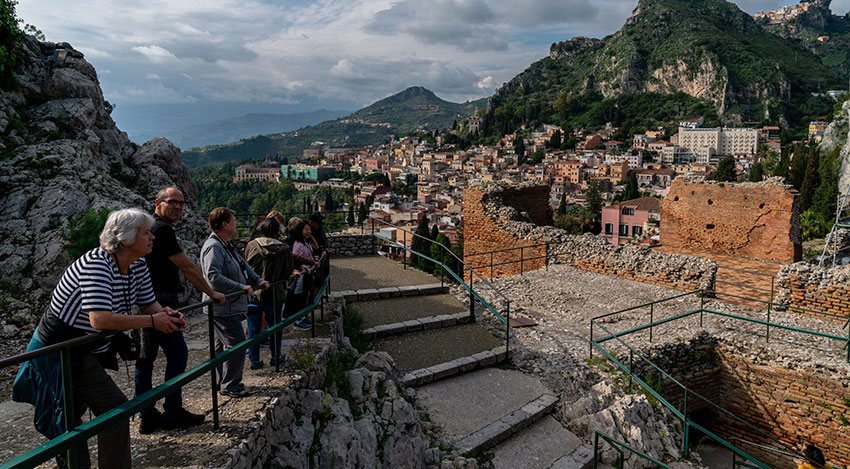Campus of the Year Feature: Mediterranean Italy
In celebration of our 2023 Campus of the Year, we will be regularly sharing stories, recipes and recommendations about Italy! From its history and culture to a few of our favorite learning adventures, follow along to learn more about this fascinating country all year long!
Spread out along the western coastline of Italy lies the Mediterranean region, dotted with cultural centers, beaches with pristine blue water and islands like Sicily and Capri. If you enjoy learning about rich history while surrounded by stunning coastal views, the Mediterranean region of Italy is for you!
Here are just a few things you should know about this amazing region:

What You Can Expect to See
Mediterranean Italy encompasses a large area of the country, including cities like Naples and much of the southern “toe” of Italy. Depending on where you venture in this region, you’ll find a variety of treasures, from the ancient ruins of Pompeii to the natural wonders along the water. A sample of the experiences you might have include
- Visiting the Norman Cathedral in Monreale; the Byzantine-style mosaics rival those of St. Mark's in Venice.
- Riding along the Circumetnea Railway around the base of Mount Etna, learning about one of the world’s most active volcanoes and taking in views of lava fields.
- Viewing the famed bronzes housed at the Museo Nazionale della Magna Grecia, exploring prehistoric Graeco-Roman and medieval antiquities.
- Reveling in the beauty of the Island of Capri as you learn from an expert about its unique geology and long history.

What You Should Eat
When it comes to Mediterranean Italy (or any region of Italy, for that matter), one thing that you simply must try is the pizza! Two styles that stand out here are Neapolitan pizza and Sicilian pizza. Neapolitan pizza, or pizza Napoletana, is characterized by its simple ingredients and smaller size, usually closer to a personal pizza than a pie meant for sharing. If you like fresh mozzarella cheese and basil, rich olive oil and lots of tomato sauce, this is the pizza for you!
Sicilian pizza, as you might guess, comes from Sicily. It is also known as sfincione, which loosely translates to “thick sponge,” due to the thick crust that forms its base. This crust is less crispy and more fluffy, and it is topped with a meatless sauce flavored with herbs, breadcrumbs and sometimes grated cheese. Some defining features of authentic Sicilian pizza are its square shape and lack of mozzarella cheese — mozzarella is typically made with cow’s milk, but most of the milk in Sicily is produced by goats or sheep.

What to Expect About Getting Around
No matter which part of Italy you explore, walking will be an integral part of your experience. Bring along comfortable, sturdy shoes to navigate the many cobblestones and rail-less stairways you may encounter. While your bus will bring you as close as possible to the landmarks you have dreamed of exploring, many of these locations prohibit vehicles from getting too close and you will need to walk the remainder of the way.
Pro tip: if you have mobility issues, bring along a mobile cane chair to help you navigate uneven pathways and offer you a place to sit and rest when needed.

What to Bring
Fashion in Italy is important but it is also important to dress smart. Religious sites have staff enforcing dress codes requiring covered knees and shoulders. It is also wise to purchase a body wallet to prevent your passport, money and other valuables from being stolen by professional pickpockets. Carrying a small crossbody bag, worn to your front, zipped shut and held with one hand, can prevent theft.
Especially during the summer months, having water on hand is a good idea. Rather than having to purchase plastic bottled water, bring your own reusable water bottle to retrieve fresh potable water from one of the many water fountains. Clean drinking water from the local mountains is readily available across most regions in Italy.
Pro tip: Prepare for your learning adventure with a book from our Italy booklist!

Have Free Time? Check Out These Things
- The Naples National Archeological Museum
Here is your chance to explore ancient art and artifacts in one impressive location. This museum holds many objects from the Roman cities of Pompeii and Herculaneum, which were destroyed by the volcanic eruption of Mt. Vesuvius. From frescoes and mosaics to statues and jewelry, experience the life and artwork of the ancient Romans up close. - The towns and scenery of the Amalfi Coast
Once a powerful maritime republic, the medieval architecture of the Amalfi Coast lends its name to one of Italy’s most captivating stretches of coastline. The coast’s stunning geography lends its hand to maritime travel, where panoramic views are a spectacle to behold, and hiking trails offer a reprieve from the more popular towns. Encompassing the best the Amalfi Coast has to offer, the three towns of Positano, Amalfi and Ravello each have their own enchanting charm. - The historic Valley of the Temples
If ancient history is your passion, this is your chance to quite literally walk in the footsteps of ancient Greeks, who long ago resided in this area of Italy. Located near Agrigento, Sicily, the Valley of the Temples is home to ruins of Hellenic temples and has been named a UNESCO World Heritage Site.
Are you ready to join us in Italy, our 2023 Campus of the Year? Find your next great adventure on our website!
